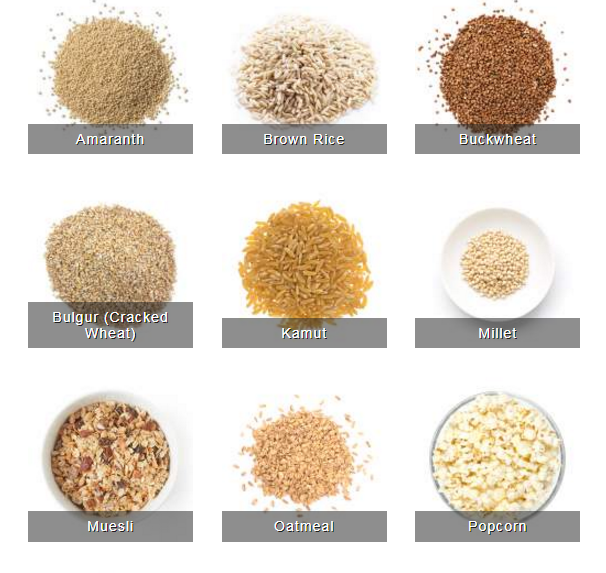What foods are in the Grains Group?
Below are only a few examples: 
Any food made from wheat, rice, oats, cornmeal, barley or another cereal grain is a grain product. Bread, pasta, oatmeal, breakfast cereals, tortillas, and grits are examples of grain products.
Grains are divided into 2 subgroups, Whole Grains and Refined Grains. Whole grains contain the entire grain kernel ― the bran, germ, and endosperm. Examples of whole grains include whole-wheat flour, bulgur (cracked wheat), oatmeal, whole cornmeal, and brown rice. Refined grains have been milled, a process that removes the bran and germ. This is done to give grains a finer texture and improve their shelf life, but it also removes dietary fiber, iron, and many B vitamins. Some examples of refined grain products are white flour, de-germed cornmeal, white bread, and white rice.
Most refined grains are enriched. This means certain B vitamins (thiamin, riboflavin, niacin, folic acid) and iron are added back after processing. Fiber is not added back to enriched grains. Check the ingredient list on refined grain products to make sure that the word “enriched” is included in the grain name. Some food products are made from mixtures of whole grains and refined grains.
How many grain foods are needed daily?
The amount of grains you need to eat depends on your age, sex, and level of physical activity. Recommended daily amounts are listed in this table below. Most Americans consume enough grains, but few are whole grains. At least half of all the grains eaten should be whole grains.
| DAILY GRAIN TABLE | |||
|---|---|---|---|
| DAILY RECOMMENDATION* | DAILY MINIMUM AMOUNT OF WHOLE GRAINS | ||
| Children | 2-3 years old 4-8 years old |
3 ounce equivalents 5 ounce equivalents |
1 ½ ounce equivalents 2 ½ ounce equivalents |
| Girls | 9-13 years old 14-18 years old |
5 ounce equivalents 6 ounce equivalents |
3 ounce equivalents 3 ounce equivalents |
| Boys | 9-13 years old 14-18 years old |
6 ounce equivalents 8 ounce equivalents |
3 ounce equivalents 4 ounce equivalents |
| Women | 19-30 years old 31-50 years old 51+ years old |
6 ounce equivalents 6 ounce equivalents 5 ounce equivalents |
3 ounce equivalents 3 ounce equivalents 3 ounce equivalents |
| Men | 19-30 years old 31-50 years old 51+ years old |
8 ounce equivalents 7 ounce equivalents 6 ounce equivalents |
4 ounce equivalents 3 ½ ounce equivalents 3 ounce equivalents |
*These amounts are appropriate for individuals who get less than 30 minutes per day of moderate physical activity, beyond normal daily activities. Those who are more physically active may be able to consume more while staying within calorie needs.
What counts as an ounce-equivalent of grains?
In general, 1 slice of bread, 1 cup of ready-to-eat cereal, or ½ cup of cooked rice, cooked pasta, or cooked cereal can be considered as 1 ounce-equivalent from the Grains Group. The table below lists specific amounts that count as 1 ounce-equivalent of grains towards your daily recommended intake. In some cases the number of ounce-equivalents for common portions are also shown.
For more info and recipes:
